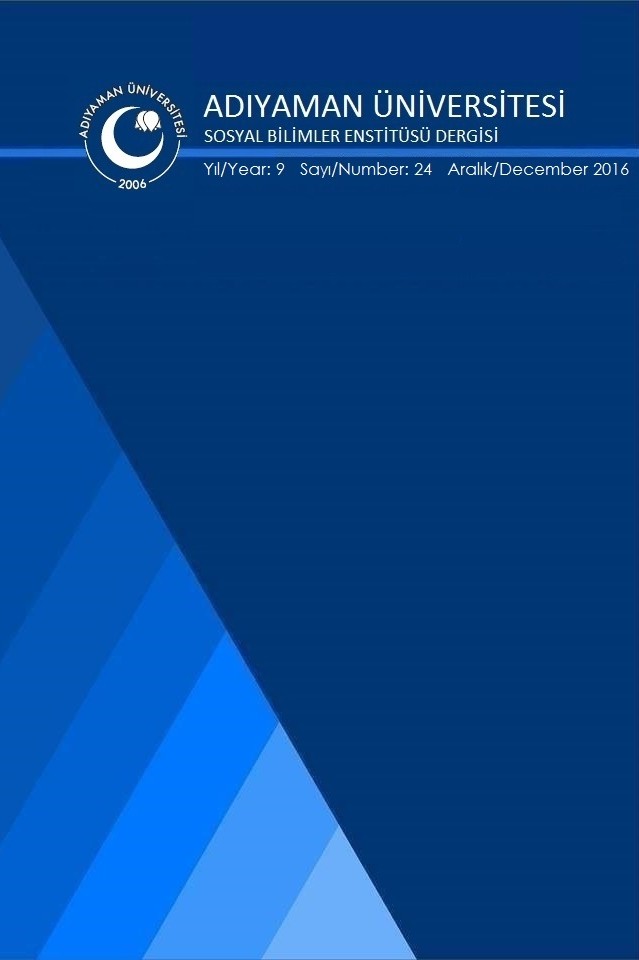Kimlik Krizinden Kriz Kimliğine: Doris Lessing’in Altin Defter’inde Kimlikler Geçidi
parçalanmış/bölünmüş kimlik, kimlik krizi, kriz kimliği, Doris Lessing, Altın Defter.
From the Identity Crisis to the Crisis Identity: The Rite of Identities in the Golden Notebook by Doris Lessing
fragmented/divided identity, identity crisis, crisis identity, Doris Lessing, The Golden Notebook.,
___
BOONE, Joseph Allen (1998). Libidinal Currents: Sexuality and the Shaping of Modernismı, Chicago: University of Chicago Press.COHEN, Mary (1977). “Out of The Chaos a New Kind of Strength: Doris Lessing’s The Golden Notebook”, Arlyn Diamond, Lee R Edwards (ed.), The Authority of Experience: Essays in Feminist Criticism, Amherst: University of Massachusetts Press, s. 178-93.
DRAINE, Betsy (1983). Substance Under Pressure: Coherence and Evolving Form in the Novels of Dorris Lessing, Madison, Wisconsin, London: University of Wisconsin Press.
DUNN, Robert G. (1998). Identity Crises: A Social Critique of Postmodernity, Minneapolis: University of Minnesota Press.
DUYFHUIZEN, Bernard (1992). Narratives of Transmission, Cranbury, NJ, London: Associated University Presses.
FAND, Roxanne J. (1999). The Dialogic Self: Reconstructing Subjectivity in Woolf, Lessing, and Atwoodı, Cranbury NJ, London: Associated University Presses.
GEORGESCU, Anca, “Self as Narrative in Doris Lessing's The Golden Notebook”, http://lcce. valahia.ro/volum/16.ageorgescu.pdf (ty) (erişim: 2. 2. 2009).Lessing, Doris (1998). Altın Defter, Cilt 1-2, çev. Aslı Çelik, İstanbul: Can Yayınları.
LOMBARDI, Giancarlo (2002). Rooms with a View: Feminist Diary Fiction, 1952-1999ı, Cranbury NJ, London: Associated University Presses.
MAMOTO, Suzuko (2006). “The Quest For Integration in Doris Lessing’s The Golden Notebook”, Fukuoka University review of literature & humanities, vol. 38, no. 2, ss. 563-586.
MEANEY, Gerardine (1993). (Un)like Subjects: Women, Theory, Fictionı, London, New York: Routledge.
MICHAEL, Magali Cornier (1996). Feminism and the Postmodern Impulse: Post-World War II Fiction, Albany: State University of New York Press.
MOYA, Paula M. L.; Hames-García, Michael R. (2000). Reclaiming Identity: Realist Theory and the Predicament of Postmodernism, Berkeley, CA: University of California Press
RIGNEY, Barbara Hill (1978). Madness and Sexual Politics in the Feminist Novel: Studies in Brontë, Woolf, Lessing, and Atwood, Madison, Wisconsin, London: University of Wisconsin Press.
RUBENSTEIN, Roberta (1979). The Novelistic Vision of Doris Lessing: Breaking the Forms of Consciousness, Urbana: University of Illinois Press.
TAYLOR, Charles (1989). Sources of the Self: The Making of the Modern Identity, Cambridge, Massachusetts: Harvard University Press.
WATSON, Barbara Bellow (1976). “Leaving the Safety of Myth: Doris Lessing’s The Golden Notebook”, Robert K. Morris (ed.), Old Lines, New Forces: Essays on the Contemporary British Novel, 1960-1970, ıCranbury, NJ, London: Associated University Presses.
WORTHINGTON, Majorie (2004). “Novel Construction of the Writer: Symbiotic Texts, Parasitic Authors in The Golden Notebook”, Michael J. Meyer (ed.), Literature and the Writerı, Amsterdam, New York: Rodopi, 59- 78.
- ISSN: 1308-9196
- Yayın Aralığı: Yılda 3 Sayı
- Başlangıç: 2008
- Yayıncı: Adıyaman Üniversitesi
İbrahim GİRİTLİOĞLU, Cevdet AVCIKURT
Akutagava Ryunosuke’nın “Burun” Adlı Öyküsüne Vicdan Kavramı Açısından Bir Bakış
Millî Hafıza Açısından Kahramanlık Hikâyeleri: “İleri Yavrutürk” Dergisi Örneği
Kimlik Krizinden Kriz Kimliğine: Doris Lessing’in Altin Defter’inde Kimlikler Geçidi
Avrupa Birliği Ortak Tarım ve Girişimcilik Politikalarının Değerlendirilmesi
Berlin Fonograf Arşivinde Türkiye Araştırmaları ve Alman Milli Kütüphanesinde Türk Beşlileri
Okul Yöneticilerinin Bilgi Yönetimi Stratejilerini Kullanma Düzeyleri
Mustafa SAMANCIOĞLU, Mustafa SAMANCIOĞLU, Murat BAĞLIBEL, Semih SUMMAK, Gülfem Muşlu KAYGISIZ
İVRİNDİ OVASI VE YAKIN ÇEVRESİNİN JEOMORFOLOJİSİ
Türkiye’de Yapılmış Toponomi Çalışmaları
Farklı Fakültelerdeki İşletme Öğrencilerinin Girişimciliğe Bakışları
